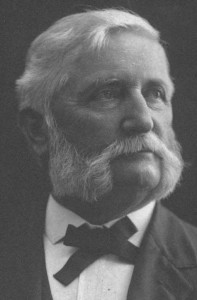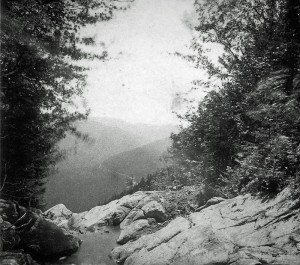True Tales: Frederic Endicott ~ A Glass of Water
By George T. ComeauAs you stand at the kitchen sink and turn on the water, reflect upon how that water makes its way through a complex system of pipes from deep wells and through a well-established network, ending at the glass of water in your hands. The person most responsible for our modern system of wells and clean water supply was Frederic Endicott.

Frederic Endicott, Canton’s first water commissioner circa 1900 (Courtesy of the Canton Historical Society)
Endicott falls into that rare category of being the quintessential “Renaissance man.” Endicott was a man who mastered the sciences, arts, nature, and a world beyond the four corners of Canton. The fact that Canton is so well understood and measured is a testament to one of our leading civil engineers.
Born in 1839, the eldest of three sons of John and Matilda (Ellis), Endicott was a direct descendant of Gilbert Indicott, the first person to be buried in the Canton Corner Cemetery. The Endicott family was well established and well respected. The family ancestry claims most of the founders of Stoughton and subsequently Canton. Descended from such families as Crane, Dean, Puffer, Fairbanks, Clapp and Vose, this is one of Canton’s first families, and Endicott took his station in life very seriously.
The Endicott family house where Frederic was born still stands on Washington Street, the beautiful brick home just north of the present high school. This was that house that was built after a fire destroyed the original. So well regarded was this family that shortly after the fire in 1806, a petition was circulated throughout the town that read: “We the subscribers commiserating the misfortunes of Mr. James Endicott by the loss of his house by fire are desirous to show our sympathy towards him by furnishing the sums annexed to our names in order that he may be enabled in part to furnish himself with a house against the approaching season.” The first name signed to the petition of 31 names is that of Paul Revere.
Endicott attended Canton Public Schools, and since we did not have a high school at the time, he also attended Dedham High School. At the age of 17, in 1855, his father died of heart disease. The family was left a house, more than 25 acres of land, and three cows as his estate. It is likely that at this time Endicott met Henry Walling, who was surveying Canton for the Walling Map. A family letter dated April 29, 1856, observes, “Fred learning geometry, going to Providence with Walling.” This would become Endicott’s life work: drafting, surveying, mapmaking and measuring.
Over the course of two years, the young draftsman would travel from Maine to New Brunswick while working from Walling’s New York offices. In 1862, Endicott was surveying in central Pennsylvania. It was the love of mountains, perhaps inspired by the Blue Hills, that Endicott pursued measuring and climbing the White Mountains of New Hampshire. It was Endicott who measured and charted the carriage road from Glen House to the summit of Mt. Washington for the State Map of New Hampshire. The trips to the White Mountains would be repeated throughout his life, and Endicott’s passion for photography would bear some of the finest early photographs of the mountains of New Hampshire.

Kedron Brook Outlook, Mt. Wiley, New Hampshire, as photographed by Frederic Endicott in 1896. (Courtesy of the Canton Historical Society)
Returning to Canton after working for Walling, Endicott became the county commissioner of Norfolk County. He gained acclaim throughout the region for his work on behalf of the commission that yielded modern roads, civic improvements, and a stronger county seat. In Canton, Endicott, ever civic-minded, threw himself into the development of a new and improved system of water distribution.
Water in the mid 19th century was a serious business, and clean water in a town burgeoning with industry and flourishing with growth was an absolute necessity. The Annual Report of the Board of Health in 1887 reported that “our wells have become entirely useless for domestic purposes, from the close proximity to privies and cesspools, thus forming a nidus for the reception of contagious miasmata, which is liable at any time to bring upon our people epidemic disease.” Imagine a “nidus for miasmata” — it sounds so horrible, surely something had to be done. In fact, in the summer of 1888 an epidemic raged through the Kinsley Iron Works, sickening many and killing a few…
Click here to read Part 2 of George Comeau’s profile on Frederic Endicott, or read the complete history of Endicott and his contributions to Canton in this week’s issue of the Canton Citizen.
Short URL: https://www.thecantoncitizen.com/?p=11349










